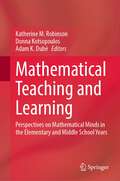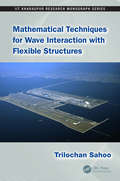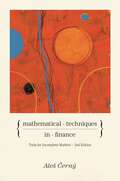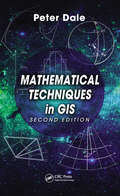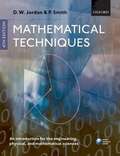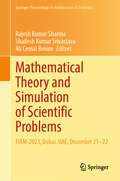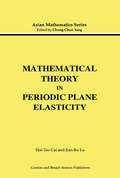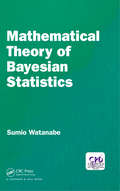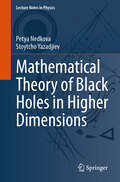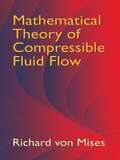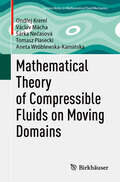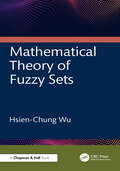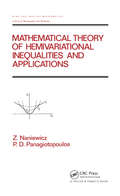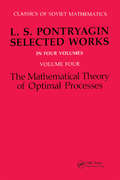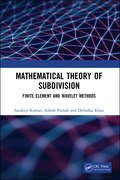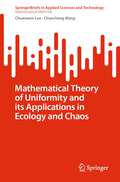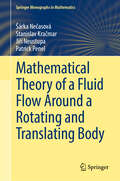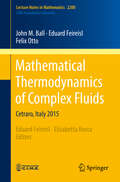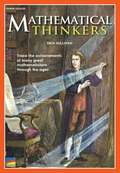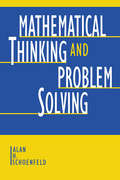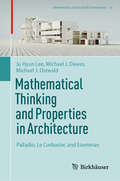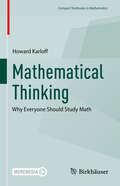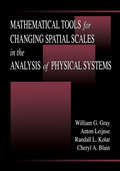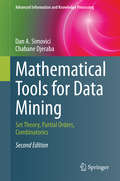- Table View
- List View
Mathematical Teaching and Learning: Perspectives on Mathematical Minds in the Elementary and Middle School Years
by Katherine M. Robinson Donna Kotsopoulos Adam K. DubéThis book focusses on teaching and learning in elementary and middle school mathematics and suggests practices for teachers to help children be successful mathematical thinkers. Contributions from diverse theoretical and disciplinary perspectives are explored. Topics include the roles of technology, language, and classroom discussion in mathematics learning, the use of creativity, visuals, and teachers’ physical gestures to enhance problem solving, inclusive educational activities to promote children’s mathematics understanding, how learning in the home can enhance children’s mathematical skills, the application of mathematics learning theories in designing effective teaching tools, and a discussion of how students, teachers, teacher educators, and school boards differentially approach elementary and middle school mathematics. This book and its companion, Mathematical Cognition and Understanding, take an interdisciplinary perspective to mathematical learning and development in the elementary and middle school years. The authors and perspectives in this book draw from education, neuroscience, developmental psychology, and cognitive psychology. The book will be relevant to scholars/educators in the field of mathematics education and also those in childhood development and cognition. Each chapter also includes practical tips and implications for parents as well as for educators and researchers.
Mathematical Techniques for Wave Interaction with Flexible Structures (IIT Kharagpur Research Monograph Series)
by Trilochan SahooMathematical Techniques for Wave Interaction with Flexible Structures is a thoughtful compilation of the various mathematical techniques used to deal with wave structure interaction problems. The book emphasizes unique determination of the solution for a class of physical problems associated with Laplace- or Helmholtz-type equations satisfying high
Mathematical Techniques in Finance: Tools for Incomplete Markets - Second Edition
by Ales CernýOriginally published in 2003, Mathematical Techniques in Finance has become a standard textbook for master's-level finance courses containing a significant quantitative element while also being suitable for finance PhD students. This fully revised second edition continues to offer a carefully crafted blend of numerical applications and theoretical grounding in economics, finance, and mathematics, and provides plenty of opportunities for students to practice applied mathematics and cutting-edge finance. Ales Cerný mixes tools from calculus, linear algebra, probability theory, numerical mathematics, and programming to analyze in an accessible way some of the most intriguing problems in financial economics. The textbook is the perfect hands-on introduction to asset pricing, optimal portfolio selection, risk measurement, and investment evaluation. The new edition includes the most recent research in the area of incomplete markets and unhedgeable risks, adds a chapter on finite difference methods, and thoroughly updates all bibliographic references. Eighty figures, over seventy examples, twenty-five simple ready-to-run computer programs, and several spreadsheets enhance the learning experience. All computer codes have been rewritten using MATLAB and online supplementary materials have been completely updated. A standard textbook for graduate finance courses Introduction to asset pricing, portfolio selection, risk measurement, and investment evaluation Detailed examples and MATLAB codes integrated throughout the text Exercises and summaries of main points conclude each chapter
Mathematical Techniques in GIS
by Peter DaleThe second edition of a bestseller, Mathematical Techniques in GIS demystifies the mathematics used in the manipulation of spatially related data. The author takes a step-by-step approach through the basics of arithmetic, algebra, geometry, trigonometry and calculus that underpin the management of such data. He then explores the use of matrices, de
Mathematical Techniques: An Introduction For The Engineering, Physical, And Mathematical Sciences
by Peter Smith Dominic JordanMathematical concepts and theories underpin engineering and many of the physical sciences. Yet many engineering and science students find math challenging and even intimidating. The fourth edition of Mathematical Techniques provides a complete course in mathematics, covering all the essential topics with which a physical sciences or engineering student should be familiar. By breaking the subject into small, modular chapters, the book introduces and builds on concepts in a progressive, carefully-layered way - always with an emphasis on using math to the best effect, rather than relying on theoretical proofs. With a huge array of end of chapter problems and new self-check questions, the fourth edition of Mathematical Techniques provides extensive opportunities for students to exercise and enhance their mathematical knowledge and skills.
Mathematical Technology of Networks
by Delio MugnoloDynamical models on graphs or random graphs are increasingly used in applied sciences as mathematical tools to study complex systems whose exact structure is too complicated to be known in detail. Besides its importance in applied sciences, the field is increasingly attracting the interest of mathematicians and theoretical physicists also because of the fundamental phenomena (synchronization, phase transitions etc. ) that can be studied in the relatively simple framework of dynamical models of random graphs. This volume was developed from the Mathematical Technology of Networks conference held in Bielefeld, Germany in December 2013. The conference was designed to bring together functional analysts, mathematical physicists, and experts in dynamical systems. The contributors to this volume explore the interplay between theoretical and applied aspects of discrete and continuous graphs. Their work helps to close the gap between different avenues of research on graphs, including metric graphs and ramified structures.
Mathematical Theory and Simulation of Scientific Problems: FIAM-2023, Dubai, UAE, December 21–22 (Springer Proceedings in Mathematics & Statistics #487)
by Rajesh Kumar Sharma Ali Cemal Benim Shailesh Kumar SrivastavaThis book contains select chapters of proceedings presented at the 6th International Conference on Frontiers in Industrial and Applied Mathematics (FIAM-2023), held at the Birla Institute of Technology and Science, Pilani-Dubai Campus, UAE, on 21–22 December 2023. It deals with mathematical theory and its applications to the various disciplines of engineering and sciences. The book illustrates the mathematical simulation of scientific problems and cutting-edge development in multiple branches of mathematics, including various computational and modeling techniques with case studies and concrete examples. The book is useful to graduate students, research scholars and professionals who are interested in the real applications of mathematics in the areas of computational and theoretical fluid dynamics, server queues, Lie group theory, fixed point theory, image processing, biomathematics, nonlinear dynamics and approximation theory.
Mathematical Theory in Periodic Plane Elasticity (Modern Analysis Series)
by Hai-Tao Cai Jian-Ke LuPresenting the mathematical theory of period problems in plane elasticity by methods of complex variables. The most general formulations of such problems are proposed under the assumption that the stresses are periodic and the displacements are quasi-periodic. The general expression of complex displacements are illustrated. Periodic welding problem
Mathematical Theory of Bayesian Statistics
by Sumio WatanabeMathematical Theory of Bayesian Statistics introduces the mathematical foundation of Bayesian inference which is well-known to be more accurate in many real-world problems than the maximum likelihood method. Recent research has uncovered several mathematical laws in Bayesian statistics, by which both the generalization loss and the marginal likelihood are estimated even if the posterior distribution cannot be approximated by any normal distribution. <P><P> Features <li>Explains Bayesian inference not subjectively but objectively. <li>Provides a mathematical framework for conventional Bayesian theorems. <li>Introduces and proves new theorems. <li>Cross validation and information criteria of Bayesian statistics are studied from the mathematical point of view. <li>Illustrates applications to several statistical problems, for example, model selection, hyperparameter optimization, and hypothesis tests. <li>This book provides basic introductions for students, researchers, and users of Bayesian statistics, as well as applied mathematicians. <P><P>Author <P><P>Sumio Watanabe is a professor of Department of Mathematical and Computing Science at Tokyo Institute of Technology. He studies the relationship between algebraic geometry and mathematical statistics.
Mathematical Theory of Black Holes in Higher Dimensions (Lecture Notes in Physics #1031)
by Petya Nedkova Stoytcho YazadjievThis book portraits the mathematical theory which lies behind black hole solutions in spacetimes with an extra dimension. Step by step the authors build a comprehensive picture of the main concepts and tools necessary to understand these geometries. In this way the book addresses questions like: How do we describe black holes in higher dimensions? How can we construct such geometries explicitly as exact solutions to the field equations? How many independent solutions can exist and how are they classified?The book concentrates on five-dimensional stationary and axisymmetric spacetimes in electro-vacuum and systematically introduces the most important black geometries which can arise in these settings. The authors follow the natural progress of the research area by initially describing the first results that were obtained intuitively and sparkled interest in the community. Then the elaborate mathematical techniques are introduced which allow to systematically construct exact black hole solutions. Topics like the integrability of the theory, the hidden symmetries of the field equations, the available Bäcklund transformations and solution generation techniques based on the inverse scattering method are covered. The last part of the book is devoted to uniqueness theorems showing how to classify the black hole spacetimes and distinguish the non-equivalent ones.The book is not just a mere collection of facts but a methodological description of the most important mathematical techniques and constructions in an active research area. The discussion is pedagogical and all the methods are demonstrated on a variety of examples. Most of the book is adapted to the level of a graduate student possessing a basic knowledge of general relativity and differential equations, and can serve as a practical guide for quickly acquiring the specific concepts and calculation techniques. Both authors have contributed to the research area by their original results, and share their own experience and perspective.
Mathematical Theory of Compressible Fluid Flow
by Richard Von MisesA pioneer in the fields of statistics and probability theory, Richard von Mises (1883-1953) made notable advances in boundary-layer-flow theory and airfoil design. This text on compressible flow, unfinished upon his sudden death, was subsequently completed in accordance with his plans, and von Mises' first three chapters were augmented with a survey of the theory of steady plane flow. Suitable as a text for advanced undergraduate and graduate students -- as well as a reference for professionals -- Mathematical Theory of Compressible Fluid Flow examines the fundamentals of high-speed flows, with detailed considerations of general theorems, conservation equations, waves, shocks, and nonisentropic flows.In this, the final work of his distinguished career, von Mises summarizes his extensive knowledge of a central branch of fluid mechanics. Characteristically, he pays particular attention to the basics, both conceptual and mathematical. The novel concept of a specifying equation clarifies the role of thermodynamics in the mechanics of compressible fluids. The general theory of characteristics receives a remarkably complete and simple treatment, with detailed applications, and the theory of shocks as asymptotic phenomena appears within the context of rational mechanics.
Mathematical Theory of Compressible Fluids on Moving Domains (Advances in Mathematical Fluid Mechanics)
by Šárka Nečasová Aneta Wróblewska-Kamińska Ondřej Kreml Václav Mácha Tomasz PiaseckiThis monograph presents the existence and properties of both weak and strong solutions to the problems of the flow of a compressible fluid in a domain whose motion is prescribed. Chapters build upon the research of Lions and Feireisl with regards to weak solutions to the compressible version of the Navier-Stokes system, and extend it to problems on moving domains. The authors also show the existence of strong solutions to the compressible Navier-Stokes system for either a small time interval or small data. The opening chapters introduce the notation, tools, and problems covered in the rest of the book, emphasizing pedagogy and accessibility throughout. Mathematical Theory of Compressible Fluids on Moving Domains will be suitable for graduate students and researchers interested in mathematical fluid mechanics.
Mathematical Theory of Fuzzy Sets
by Hsien-Chung WuMathematical Theory of Fuzzy Sets presents the mathematical theory of non-normal fuzzy sets such that it can be rigorously used as a basic tool to study engineering and economic problems under a fuzzy environment. It may also be used as a textbook at the graduate level, or as a reference for researchers.The book explores the current state of affairs in set operations of fuzzy sets, arithmetic operations of fuzzy interval, and fuzzification of crisp functions, which are frequently adopted to model engineering and economic problems with fuzzy uncertainty. In particular, the concepts of gradual sets and gradual elements are presented in order to cope with the difficulty of considering elements of fuzzy sets like considering elements of crisp sets.Features Many extensions and equivalences for the essence of non-normal fuzzy sets Generalization of extension principle Presentation of the concepts of gradual sets and gradual elements
Mathematical Theory of Hemivariational Inequalities and Applications (Chapman And Hall/crc Pure And Applied Mathematics Ser.)
by P. D. Panagiotopoulos Zdzistaw NaniewiczGives a complete and rigorous presentation of the mathematical study of the expressions - hemivariational inequalities - arising in problems that involve nonconvex, nonsmooth energy functions. A theory of the existence of solutions for inequality problems involving monconvexity and nonsmoothness is established.
Mathematical Theory of Optimal Processes: Selected Works (Classics Of Soviet Mathematics Ser.)
by L.S. PontryaginThe fourth and final volume in this comprehensive set presents the maximum principle as a wide ranging solution to nonclassical, variational problems. This one mathematical method can be applied in a variety of situations, including linear equations with variable coefficients, optimal processes with delay, and the jump condition. As with the three preceding volumes, all the material contained with the 42 sections of this volume is made easily accessible by way of numerous examples, both concrete and abstract in nature.
Mathematical Theory of Subdivision: Finite Element and Wavelet Methods
by Sandeep Kumar Ashish Pathak Debashis KhanThis book provides good coverage of the powerful numerical techniques namely, finite element and wavelets, for the solution of partial differential equation to the scientists and engineers with a modest mathematical background. The objective of the book is to provide the necessary mathematical foundation for the advanced level applications of these numerical techniques. The book begins with the description of the steps involved in finite element and wavelets-Galerkin methods. The knowledge of Hilbert and Sobolev spaces is needed to understand the theory of finite element and wavelet-based methods. Therefore, an overview of essential content such as vector spaces, norm, inner product, linear operators, spectral theory, dual space, and distribution theory, etc. with relevant theorems are presented in a coherent and accessible manner. For the graduate students and researchers with diverse educational background, the authors have focused on the applications of numerical techniques which are developed in the last few decades. This includes the wavelet-Galerkin method, lifting scheme, and error estimation technique, etc. Features: • Computer programs in Mathematica/Matlab are incorporated for easy understanding of wavelets. • Presents a range of workout examples for better comprehension of spaces and operators. • Algorithms are presented to facilitate computer programming. • Contains the error estimation techniques necessary for adaptive finite element method. This book is structured to transform in step by step manner the students without any knowledge of finite element, wavelet and functional analysis to the students of strong theoretical understanding who will be ready to take many challenging research problems in this area.
Mathematical Theory of Uniformity and its Applications in Ecology and Chaos (SpringerBriefs in Applied Sciences and Technology)
by Chuanwen Luo Chuncheng WangThis book puts forward a new mathematical theory to study chaotic phenomenon. The uniform theory is established on the basis of two elementary concept of circle and externally tangent square in mathematics. The author studies the uniformity of a finite set of points distributed in space by uniform theory. This book also illustrates that uniform theory performs better than other indices such as entropy and Lyapunov exponent in chaos measurement by numerous examples. This book develops a new mathematical tool for studying chaos so it will be appealing to students and researchers interested in theory of chaos. It also has potential applications in various fields such as Engineering, Forestry and Ecology.
Mathematical Theory of a Fluid Flow Around a Rotating and Translating Body (Springer Monographs in Mathematics)
by Šárka Nečasová Patrick Penel Stanislav Kračmar Jiří NeustupaThe book deals with qualitative analysis of the mathematical model of flow of a viscous incompressible fluid around a translating and rotating body. The considered mathematical model, which represents the description of the flow in a coordinate system attached to the body, is derived from the Navier–Stokes equations by means of an appropriate transformation. The core of the book is the mathematical theory of the transformed equations. Most of the text is devoted to the theory of the linearized versions of these equations (i.e. the Stokes- and Oseen-type equations), because they play a fundamental role in the theory of the complete nonlinear system. Considering strong, weak, and very weak solutions, we present the L2 and Lq theories and the weighted space theory (with Muckenhaupt's weights) in the whole space and in an exterior domain. The book also contains the spectral analysis of the associated linear Stokes-Oseen-type operators and the information on semigroups generated by these operators, and related resolvent estimates. Moreover, the book describes the asymptotic behavior of solutions and leading profiles of solutions for linear and as well as nonlinear systems. Further, the book contains studies of the problem with artificial boundary (important in numerical analysis), an introduction to the theory of the corresponding complete nonlinear system in both steady and nonsteady cases, a brief description of the situation when the rotation is not parallel to the velocity at infinity and necessary estimates of the related Oseen kernels.
Mathematical Thermodynamics of Complex Fluids: Cetraro, Italy 2015 (Lecture Notes in Mathematics #2200)
by Eduard Feireisl Elisabetta Rocca John M. Ball Felix OttoEduard FeireislThe main goal of this book is to provide an overview of the state of the art in the mathematical modeling of complex fluids, with particular emphasis on its thermodynamical aspects. The central topics of the text, the modeling, analysis and numerical simulation of complex fluids, are of great interest and importance both for the understanding of various aspects of fluid dynamics and for its applications to special real-world problems. New emerging trends in the subject are highlighted with the intent to inspire and motivate young researchers and PhD students.
Mathematical Thinkers: Set of 6 with Teacher Materials Non Common Core Edition (Navigators Ser.)
by Alison Adams Erin Sullivan Albert HannerNIMAC-sourced textbook
Mathematical Thinking and Problem Solving (Studies in Mathematical Thinking and Learning Series)
by Alan H. SchoenfeldIn the early 1980s there was virtually no serious communication among the various groups that contribute to mathematics education -- mathematicians, mathematics educators, classroom teachers, and cognitive scientists. Members of these groups came from different traditions, had different perspectives, and rarely gathered in the same place to discuss issues of common interest. Part of the problem was that there was no common ground for the discussions -- given the disparate traditions and perspectives. As one way of addressing this problem, the Sloan Foundation funded two conferences in the mid-1980s, bringing together members of the different communities in a ground clearing effort, designed to establish a base for communication. In those conferences, interdisciplinary teams reviewed major topic areas and put together distillations of what was known about them.* A more recent conference -- upon which this volume is based -- offered a forum in which various people involved in education reform would present their work, and members of the broad communities gathered would comment on it. The focus was primarily on college mathematics, informed by developments in K-12 mathematics. The main issues of the conference were mathematical thinking and problem solving.
Mathematical Thinking and Properties in Architecture: Palladio, Le Corbusier, and Eisenman (Mathematics and the Built Environment #10)
by Michael J. Ostwald Michael J. Dawes Ju Hyun LeeThis monograph explores the profound connections between architecture and mathematics through the works of Andrea Palladio, Le Corbusier, and Peter Eisenman. Combining historical insights with computational analyses, it examines the social, spatial, and aesthetic properties of twenty-six iconic designs. Advanced methods such as Space Syntax, isovists, fractal analysis, image segmentation and semantic linguistic analysis reveal the mathematical principles underlying architectural thinking and properties. Richly illustrated with over 100 visuals, this volume is an essential resource for senior undergraduates, postgraduates, practicing architects, and historians seeking a deeper understanding of mathematical thinking in architectural design and analysis.
Mathematical Thinking: Why Everyone Should Study Math (Compact Textbooks in Mathematics)
by Howard KarloffThis textbook invites readers to explore mathematical thinking by finding the beauty in the subject. With an accessible tone and stimulating puzzles, the author will convince curious non-mathematicians to continue their studies in the area. It has an expansive scope, covering everything from probability and graph theory to infinities and Newton’s method. Many examples of proofs appear as well, offering readers the opportunity to explore these topics with the amount of rigor that suits them. Programming exercises in Python are also included to show how math behaves in action.Mathematical Thinking is an ideal textbook for transition courses aimed at undergraduates moving from lower level to more advanced topics, as well as for math recruitment and invitational courses at the freshman or sophomore level. It may also be of interest in computer science departments and can be used as a supplemental text for courses in discrete mathematics and graph theory.
Mathematical Tools for Changing Scale in the Analysis of Physical Systems
by William G. Gray Anton Leijnse Randall L. Kolar Cheryl A. BlainMathematical Tools for Changing Scale in the Analysis of Physical Systems presents a new systematic approach to changing the spatial scale of the differential equations describing science and engineering problems. It defines vectors, tensors, and differential operators in arbitrary orthogonal coordinate systems without resorting to conceptually difficult Riemmann-Christoffel tensor and contravariant and covariant base vectors. It reveals the usefulness of generalized functions for indicating curvilineal, surficial, or spatial regions of integration and for transforming among these integration regions. These powerful mathematical tools are harnessed to provide 128 theorems in tabular format (most not previously available in the literature) that transform time-derivative and del operators of a function at one scale to the corresponding operators acting on the function at a larger scale. Mathematical Tools for Changing Scale in the Analysis of Physical Systems also provides sample applications of the theorems to obtain continuum balance relations for arbitrary surfaces, multiphase systems, and problems of reduced dimensionality. The mathematical techniques and tabulated theorems ensure the book will be an invaluable analysis tool for practitioners and researchers studying balance equations for systems encountered in the fields of hydraulics, hydrology, porous media physics, structural analysis, chemical transport, heat transfer, and continuum mechanics.
Mathematical Tools for Data Mining
by Dan A. Simovici Chabane DjerabaData mining essentially relies on several mathematical disciplines, many of which are presented in this second edition of this book. Topics include partially ordered sets, combinatorics, general topology, metric spaces, linear spaces, graph theory. To motivate the reader a significant number of applications of these mathematical tools are included ranging from association rules, clustering algorithms, classification, data constraints, logical data analysis, etc. The book is intended as a reference for researchers and graduate students. The current edition is a significant expansion of the first edition. We strived to make the book self-contained and only a general knowledge of mathematics is required. More than 700 exercises are included and they form an integral part of the material. Many exercises are in reality supplemental material and their solutions are included.
